EXHIBIT 99.2
Published on October 16, 2019

Exhibit 99.2 Third Quarter 2019 Earnings Conference Call October 16, 2019 The PNC Financial Services Group
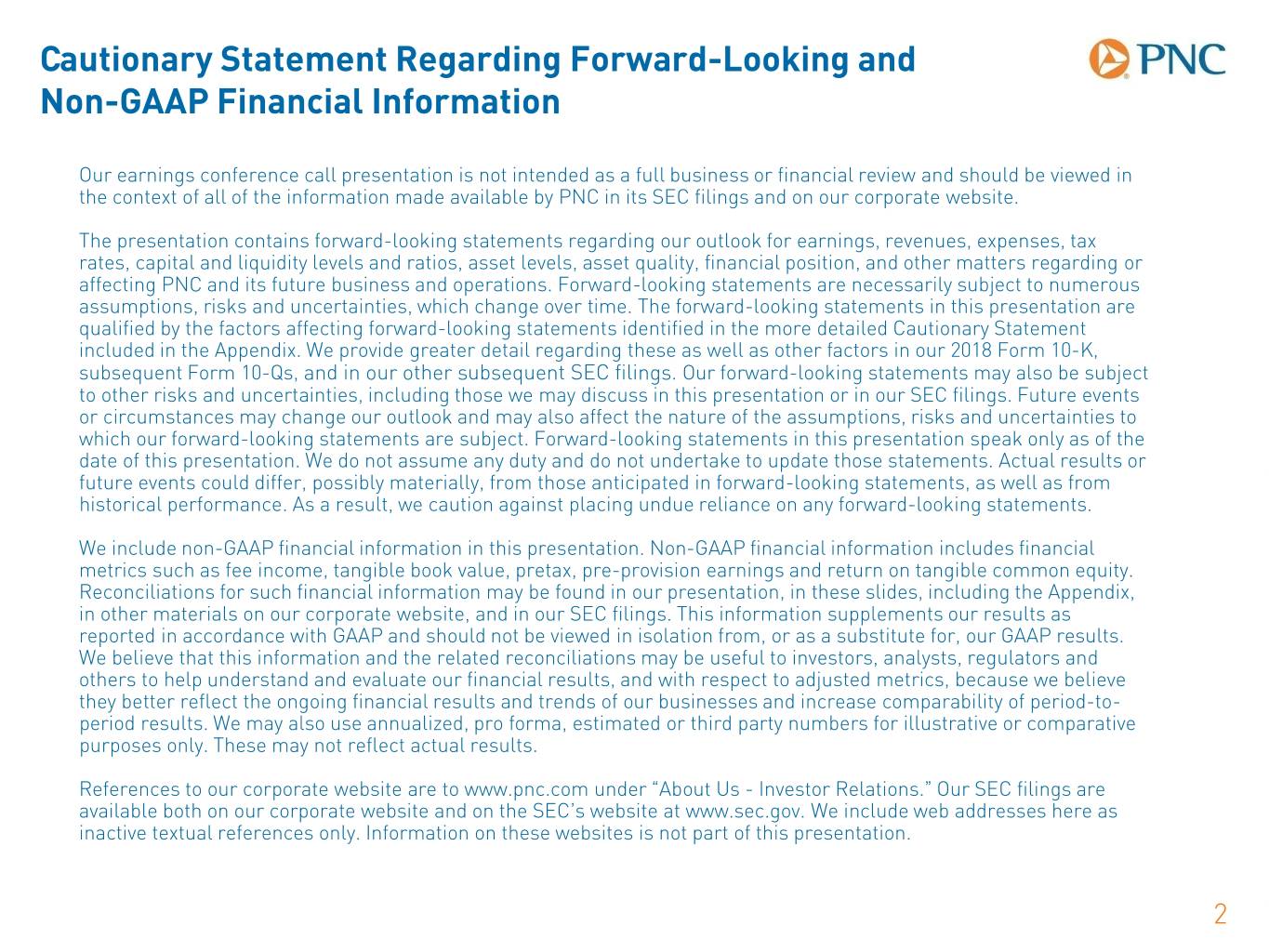
Cautionary Statement Regarding Forward-Looking and Non-GAAP Financial Information Our earnings conference call presentation is not intended as a full business or financial review and should be viewed in the context of all of the information made available by PNC in its SEC filings and on our corporate website. The presentation contains forward-looking statements regarding our outlook for earnings, revenues, expenses, tax rates, capital and liquidity levels and ratios, asset levels, asset quality, financial position, and other matters regarding or affecting PNC and its future business and operations. Forward-looking statements are necessarily subject to numerous assumptions, risks and uncertainties, which change over time. The forward-looking statements in this presentation are qualified by the factors affecting forward-looking statements identified in the more detailed Cautionary Statement included in the Appendix. We provide greater detail regarding these as well as other factors in our 2018 Form 10-K, subsequent Form 10-Qs, and in our other subsequent SEC filings. Our forward-looking statements may also be subject to other risks and uncertainties, including those we may discuss in this presentation or in our SEC filings. Future events or circumstances may change our outlook and may also affect the nature of the assumptions, risks and uncertainties to which our forward-looking statements are subject. Forward-looking statements in this presentation speak only as of the date of this presentation. We do not assume any duty and do not undertake to update those statements. Actual results or future events could differ, possibly materially, from those anticipated in forward-looking statements, as well as from historical performance. As a result, we caution against placing undue reliance on any forward-looking statements. We include non-GAAP financial information in this presentation. Non-GAAP financial information includes financial metrics such as fee income, tangible book value, pretax, pre-provision earnings and return on tangible common equity. Reconciliations for such financial information may be found in our presentation, in these slides, including the Appendix, in other materials on our corporate website, and in our SEC filings. This information supplements our results as reported in accordance with GAAP and should not be viewed in isolation from, or as a substitute for, our GAAP results. We believe that this information and the related reconciliations may be useful to investors, analysts, regulators and others to help understand and evaluate our financial results, and with respect to adjusted metrics, because we believe they better reflect the ongoing financial results and trends of our businesses and increase comparability of period-to- period results. We may also use annualized, pro forma, estimated or third party numbers for illustrative or comparative purposes only. These may not reflect actual results. References to our corporate website are to www.pnc.com under “About Us - Investor Relations.” Our SEC filings are available both on our corporate website and on the SEC’s website at www.sec.gov. We include web addresses here as inactive textual references only. Information on these websites is not part of this presentation. 2
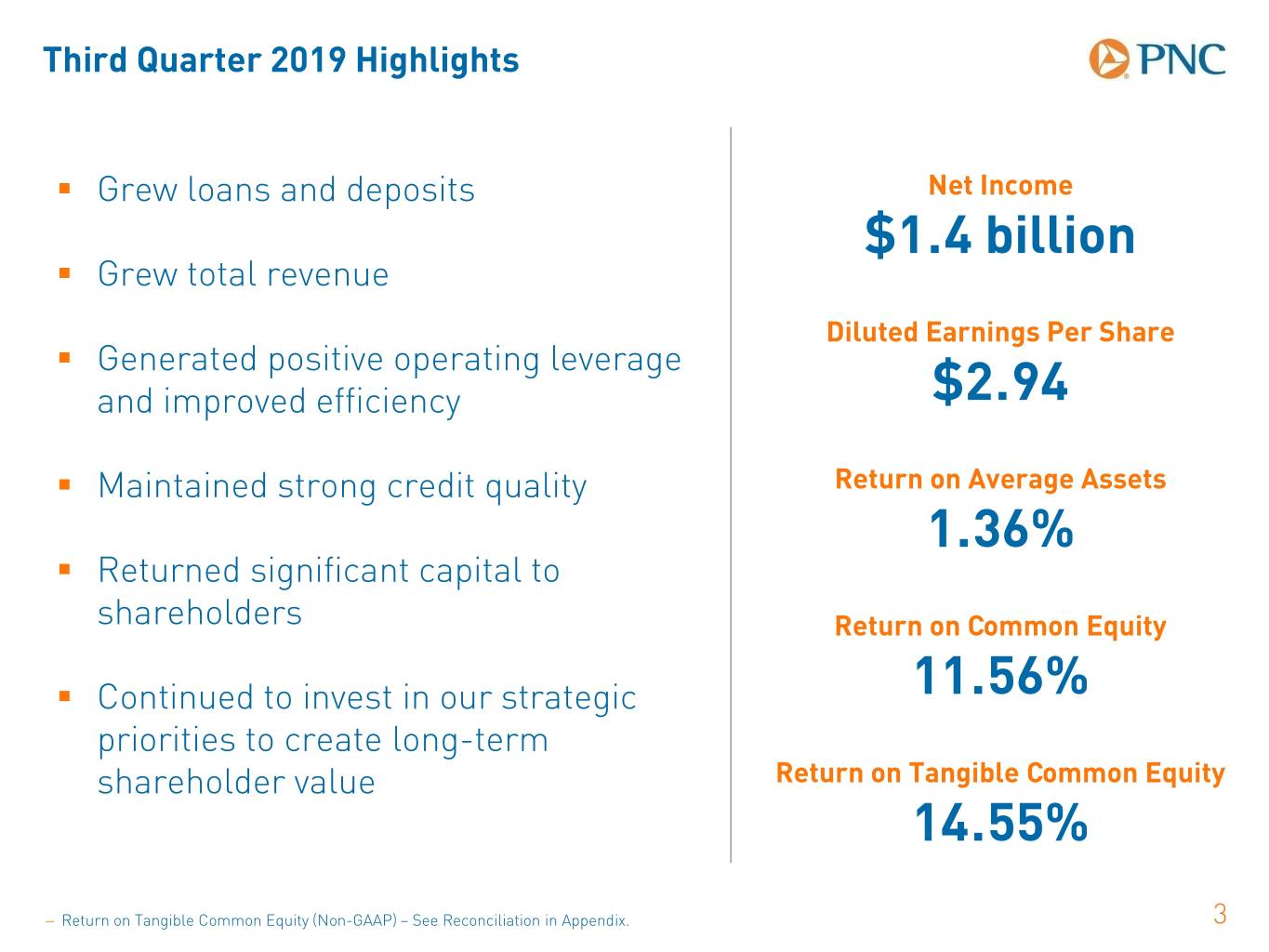
Third Quarter 2019 Highlights . Grew loans and deposits Net Income $1.4 billion . Grew total revenue Diluted Earnings Per Share . Generated positive operating leverage and improved efficiency $2.94 . Maintained strong credit quality Return on Average Assets 1.36% . Returned significant capital to shareholders Return on Common Equity . Continued to invest in our strategic 11.56% priorities to create long-term shareholder value Return on Tangible Common Equity 14.55% − Return on Tangible Common Equity (Non-GAAP) – See Reconciliation in Appendix. 3
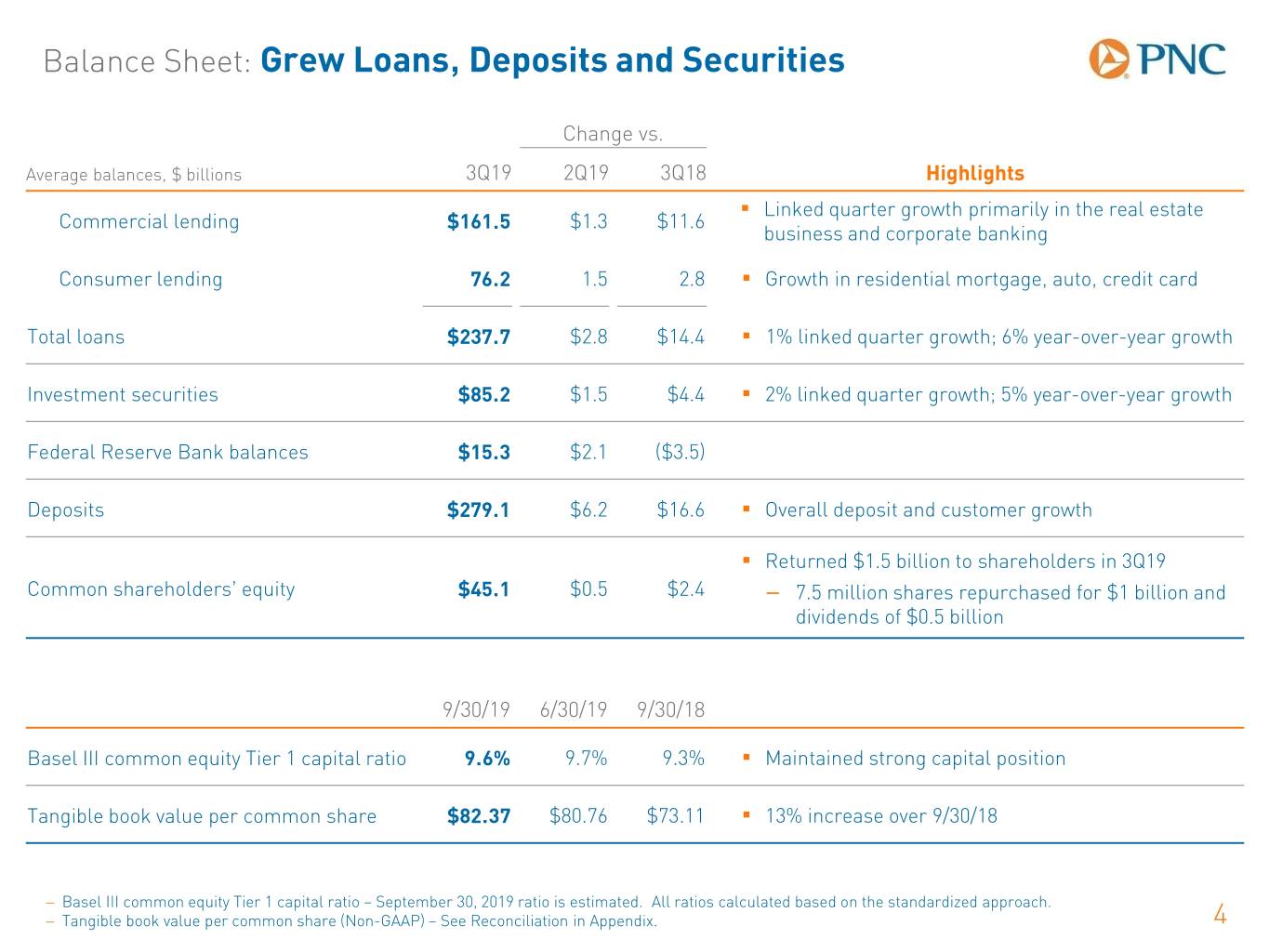
Balance Sheet: Grew Loans, Deposits and Securities Change vs. Average balances, $ billions 3Q19 2Q19 3Q18 Highlights . Linked quarter growth primarily in the real estate Commercial lending $161.5 $1.3 $11.6 business and corporate banking Consumer lending 76.2 1.5 2.8 . Growth in residential mortgage, auto, credit card Total loans $237.7 $2.8 $14.4 . 1% linked quarter growth; 6% year-over-year growth Investment securities $85.2 $1.5 $4.4 . 2% linked quarter growth; 5% year-over-year growth Federal Reserve Bank balances $15.3 $2.1 ($3.5) Deposits $279.1 $6.2 $16.6 . Overall deposit and customer growth . Returned $1.5 billion to shareholders in 3Q19 Common shareholders’ equity $45.1 $0.5 $2.4 − 7.5 million shares repurchased for $1 billion and dividends of $0.5 billion 9/30/19 6/30/19 9/30/18 Basel III common equity Tier 1 capital ratio 9.6% 9.7% 9.3% . Maintained strong capital position Tangible book value per common share $82.37 $80.76 $73.11 . 13% increase over 9/30/18 − Basel III common equity Tier 1 capital ratio – September 30, 2019 ratio is estimated. All ratios calculated based on the standardized approach. − Tangible book value per common share (Non-GAAP) – See Reconciliation in Appendix. 4
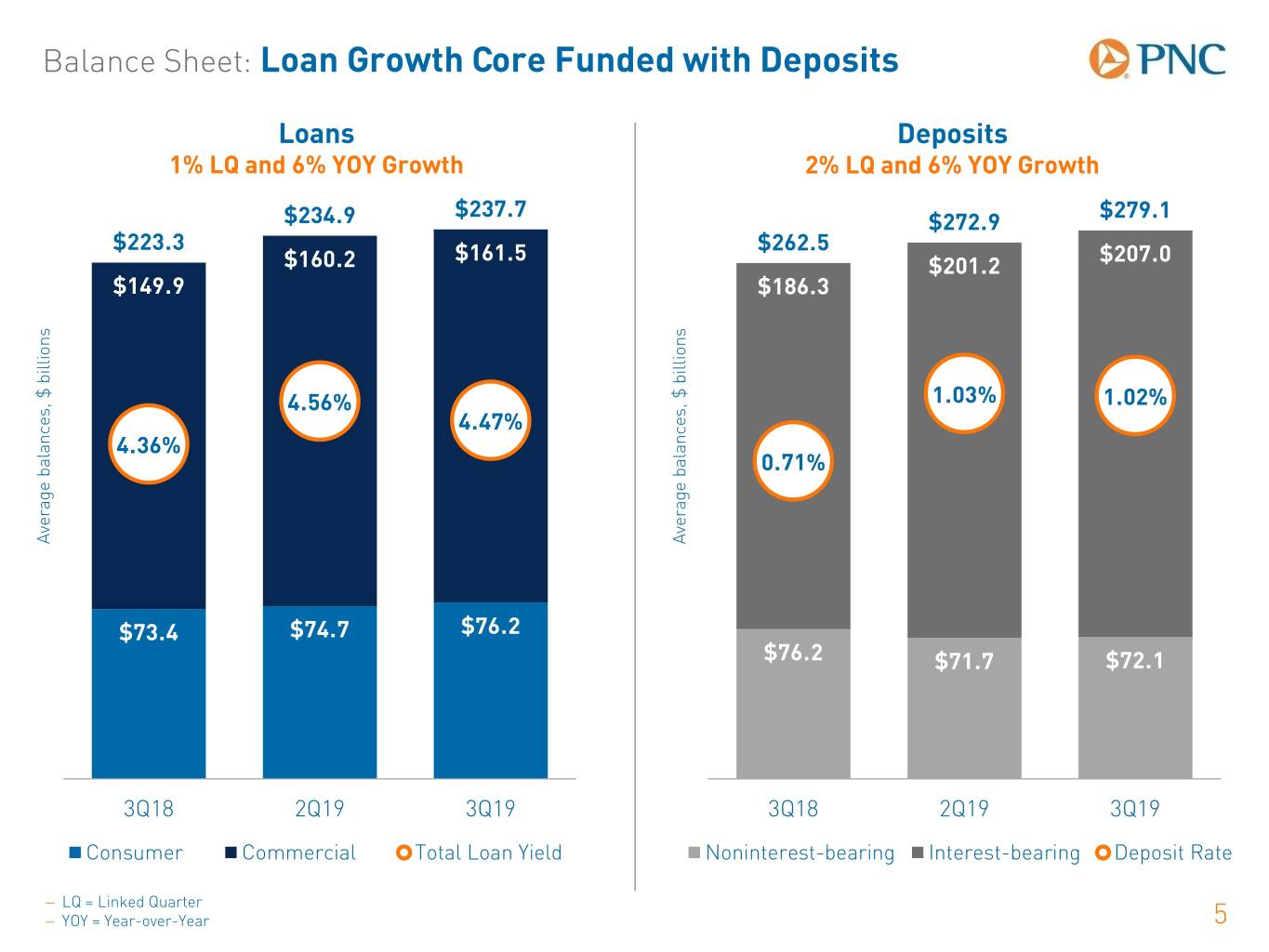
Balance Sheet: Loan Growth Core Funded with Deposits Loans Deposits 1% LQ and 6% YOY Growth 2% LQ and 6% YOY Growth $237.7 $279.1 $234.9 $272.9 $223.3 $161.5 $262.5 $207.0 $160.2 $201.2 $149.9 $186.3 4.56% 1.03% 1.02% 4.47% 4.36% 0.71% Average Average balances, $ billions Average Average balances, $ billions $73.4 $74.7 $76.2 $76.2 $71.7 $72.1 3Q18 2Q19 3Q19 3Q18 2Q19 3Q19 Consumer Commercial Total Loan Yield Noninterest-bearing Interest-bearing Deposit Rate − LQ = Linked Quarter − YOY = Year-over-Year 5

Income Statement: Strong Results, Positive Operating Leverage Change vs. $ millions 3Q19 2Q19 3Q18 Highlights . LQ growth driven by higher interest-earning asset balances Net interest income $2,504 $6 $38 and an additional day, partially offset by lower rates . Solid fee growth of 5% LQ and 4% YoY Noninterest income 1,989 48 98 . Total noninterest income growth of 2% LQ and 5% YoY Total revenue $4,493 $54 $136 . 1% linked quarter growth; 3% year-over-year growth . Generated quarterly positive operating leverage on a linked Noninterest expense $2,623 $12 $15 quarter and year-over-year basis Pretax, pre-provision earnings $1,870 $42 $121 . 2% linked quarter growth; 7% year-over-year growth Provision $183 $3 $95 . Credit quality remained strong Net income $1,392 $18 ($8) 3Q19 2Q19 3Q18 Diluted EPS $2.94 $2.88 $2.82 . 2% linked quarter growth; 4% year-over-year growth − Pretax, pre-provision earnings (Non-GAAP) – See Reconciliation in Appendix. 6
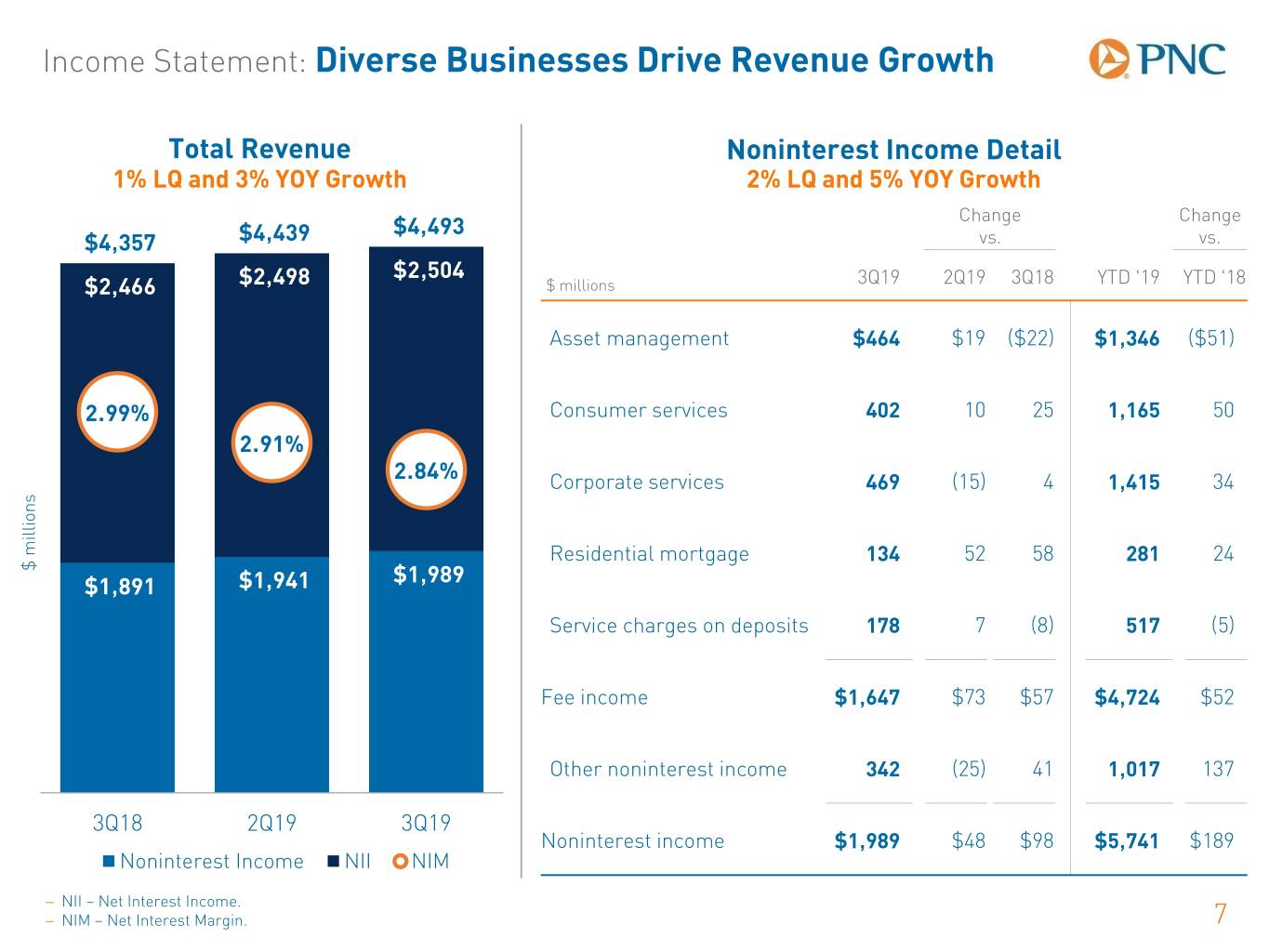
Income Statement: Diverse Businesses Drive Revenue Growth Total Revenue Noninterest Income Detail 1% LQ and 3% YOY Growth 2% LQ and 5% YOY Growth Change Change $4,493 $4,357 $4,439 vs. vs. $2,504 $2,466 $2,498 $ millions 3Q19 2Q19 3Q18 YTD ‘19 YTD ‘18 Asset management $464 $19 ($22) $1,346 ($51) 2.99% Consumer services 402 10 25 1,165 50 2.91% 2.84% Corporate services 469 (15) 4 1,415 34 Residential mortgage 134 52 58 281 24 $ millions $1,989 $1,891 $1,941 Service charges on deposits 178 7 (8) 517 (5) Fee income $1,647 $73 $57 $4,724 $52 Other noninterest income 342 (25) 41 1,017 137 3Q18 2Q19 3Q19 Noninterest income $1,989 $48 $98 $5,741 $189 Noninterest Income NII NIM − NII – Net Interest Income. − NIM – Net Interest Margin. 7

Income Statement: Focused on Expense Management Noninterest Expense Noninterest Expense Detail Efficiency Ratio Improved Stable LQ and 1% YOY Growth Change Change vs. vs. $2,608 $2,611 $2,623 $ millions 3Q19 2Q19 3Q18 YTD ‘19 YTD ‘18 Personnel $1,400 $35 ($13) $4,179 $56 Occupancy 206 (6) 11 633 17 60% 59% 58% Equipment 291 (7) 27 862 44 $ millions Marketing 76 (7) 5 224 23 Other 650 (3) (15) 1,914 (47) Noninterest expense $2,623 $12 $15 $7,812 $93 3Q18 2Q19 3Q19 Noninterest Expense Efficiency Ratio 8

Credit: Maintained Strong Credit Quality Net Charge-offs and Provision NCO / Average Loans for 3Q19: 0.26% $189 $180 $183 $148 $155 $136 $142 $107 $91 $88 $ millions 1.16% 1.16% 1.16% 1.15% 1.15% 3Q18 4Q18 1Q19 2Q19 3Q19 Net Charge-offs Provision ALLL to Total Loans Nonperforming Loans Delinquencies 0.90% $1,600 $1,400 0.80% $1,694 $1,694 $1,653 $1,724 $1,728 $1,485 $1,200 $1,428 $1,436 $1,309 $1,348 0.70% $1,000 0.66% 0.76% 0.75% $800 0.64% 0.71% 0.73% 0.73% 0.62% 0.60% $600 0.55% 0.57% $400 0.50% $ millions $ millions $200 $- 0.40% 9/30/18 12/31/18 3/31/19 6/30/19 9/30/19 9/30/18 12/31/18 3/31/19 6/30/19 9/30/19 NPLs Nonperforming Loans to Total Loans Delinquencies Delinquencies to Total Loans − ALLL – Allowance for Loan and Lease Losses. − NCO / Average Loans represents annualized net charge-offs (NCO) to average loans for the three months ended − Delinquencies represents accruing loans past due 30-days or more. Delinquencies to Total Loans represents delinquencies divided by spot loans. 9
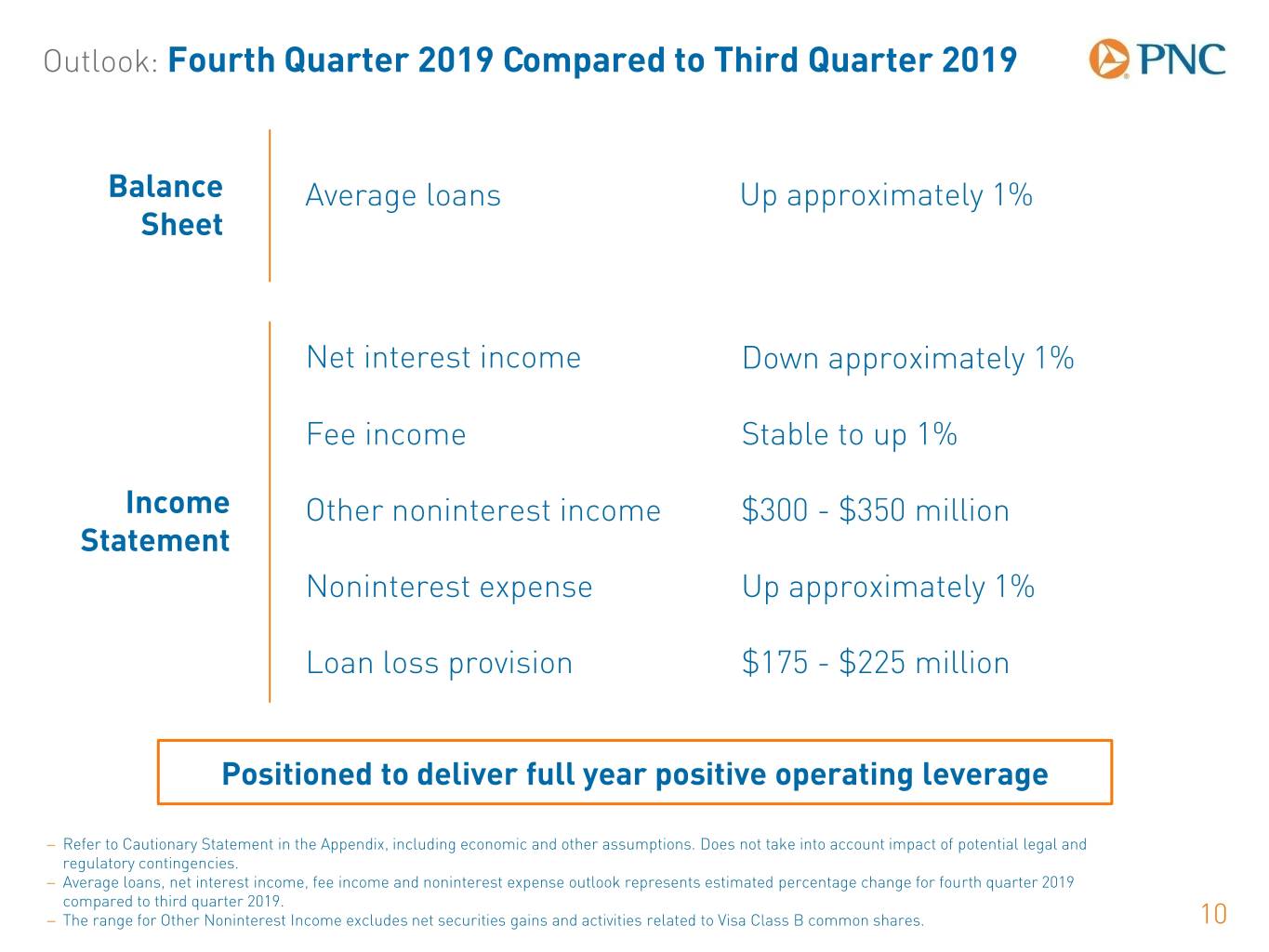
Outlook: Fourth Quarter 2019 Compared to Third Quarter 2019 Balance Average loans Up approximately 1% Sheet Net interest income Down approximately 1% Fee income Stable to up 1% Income Other noninterest income $300 - $350 million Statement Noninterest expense Up approximately 1% Loan loss provision $175 - $225 million Positioned to deliver full year positive operating leverage − Refer to Cautionary Statement in the Appendix, including economic and other assumptions. Does not take into account impact of potential legal and regulatory contingencies. − Average loans, net interest income, fee income and noninterest expense outlook represents estimated percentage change for fourth quarter 2019 compared to third quarter 2019. − The range for Other Noninterest Income excludes net securities gains and activities related to Visa Class B common shares. 10
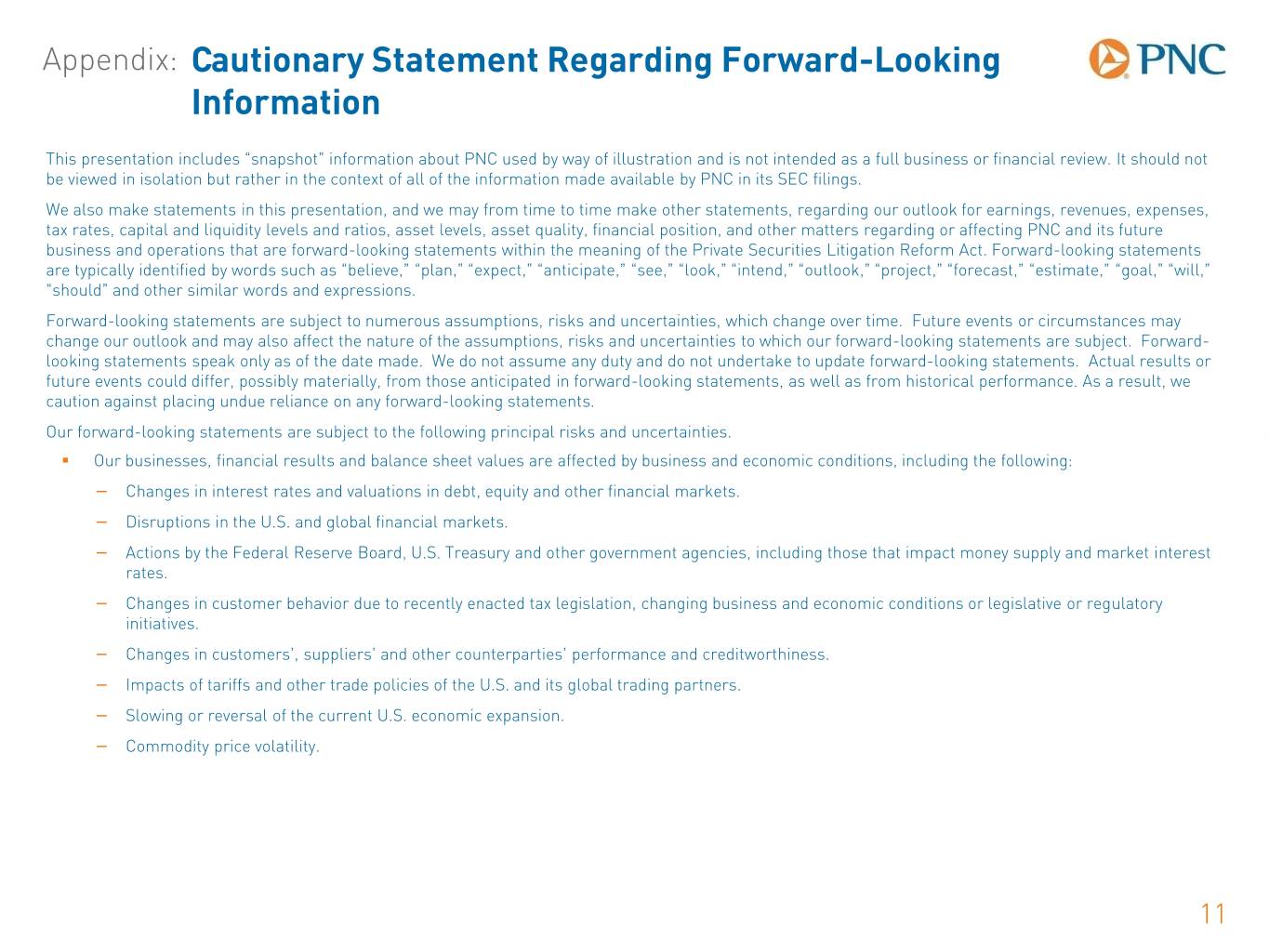
Appendix: Cautionary Statement Regarding Forward-Looking Information This presentation includes “snapshot” information about PNC used by way of illustration and is not intended as a full business or financial review. It should not be viewed in isolation but rather in the context of all of the information made available by PNC in its SEC filings. We also make statements in this presentation, and we may from time to time make other statements, regarding our outlook for earnings, revenues, expenses, tax rates, capital and liquidity levels and ratios, asset levels, asset quality, financial position, and other matters regarding or affecting PNC and its future business and operations that are forward-looking statements within the meaning of the Private Securities Litigation Reform Act. Forward-looking statements are typically identified by words such as “believe,” “plan,” “expect,” “anticipate,” “see,” “look,” “intend,” “outlook,” “project,” “forecast,” “estimate,” “goal,” “will,” “should” and other similar words and expressions. Forward-looking statements are subject to numerous assumptions, risks and uncertainties, which change over time. Future events or circumstances may change our outlook and may also affect the nature of the assumptions, risks and uncertainties to which our forward-looking statements are subject. Forward- looking statements speak only as of the date made. We do not assume any duty and do not undertake to update forward-looking statements. Actual results or future events could differ, possibly materially, from those anticipated in forward-looking statements, as well as from historical performance. As a result, we caution against placing undue reliance on any forward-looking statements. Our forward-looking statements are subject to the following principal risks and uncertainties. . Our businesses, financial results and balance sheet values are affected by business and economic conditions, including the following: − Changes in interest rates and valuations in debt, equity and other financial markets. − Disruptions in the U.S. and global financial markets. − Actions by the Federal Reserve Board, U.S. Treasury and other government agencies, including those that impact money supply and market interest rates. − Changes in customer behavior due to recently enacted tax legislation, changing business and economic conditions or legislative or regulatory initiatives. − Changes in customers’, suppliers’ and other counterparties’ performance and creditworthiness. − Impacts of tariffs and other trade policies of the U.S. and its global trading partners. − Slowing or reversal of the current U.S. economic expansion. − Commodity price volatility. 11
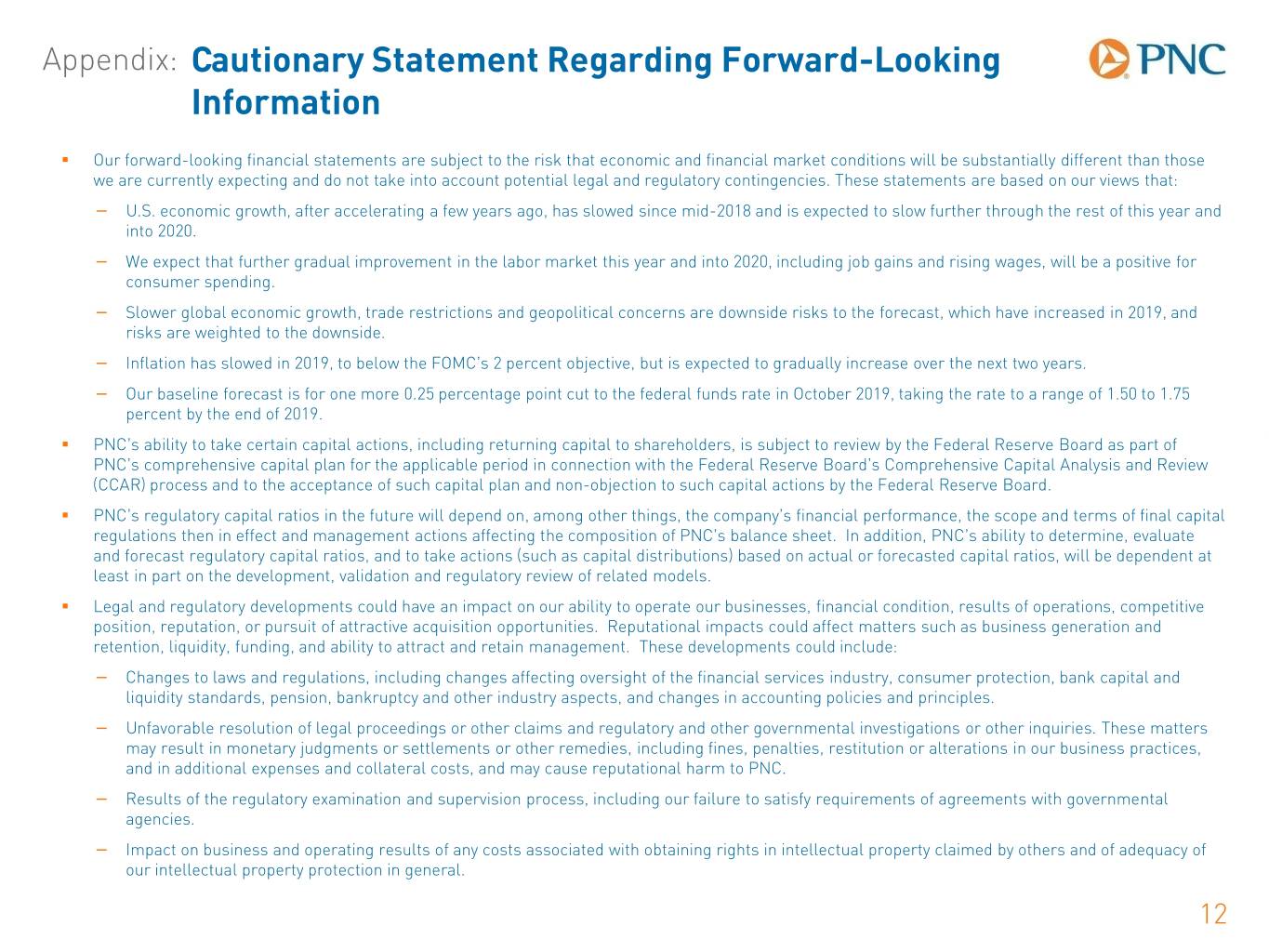
Appendix: Cautionary Statement Regarding Forward-Looking Information . Our forward-looking financial statements are subject to the risk that economic and financial market conditions will be substantially different than those we are currently expecting and do not take into account potential legal and regulatory contingencies. These statements are based on our views that: − U.S. economic growth, after accelerating a few years ago, has slowed since mid-2018 and is expected to slow further through the rest of this year and into 2020. − We expect that further gradual improvement in the labor market this year and into 2020, including job gains and rising wages, will be a positive for consumer spending. − Slower global economic growth, trade restrictions and geopolitical concerns are downside risks to the forecast, which have increased in 2019, and risks are weighted to the downside. − Inflation has slowed in 2019, to below the FOMC’s 2 percent objective, but is expected to gradually increase over the next two years. − Our baseline forecast is for one more 0.25 percentage point cut to the federal funds rate in October 2019, taking the rate to a range of 1.50 to 1.75 percent by the end of 2019. . PNC’s ability to take certain capital actions, including returning capital to shareholders, is subject to review by the Federal Reserve Board as part of PNC’s comprehensive capital plan for the applicable period in connection with the Federal Reserve Board’s Comprehensive Capital Analysis and Review (CCAR) process and to the acceptance of such capital plan and non-objection to such capital actions by the Federal Reserve Board. . PNC’s regulatory capital ratios in the future will depend on, among other things, the company’s financial performance, the scope and terms of final capital regulations then in effect and management actions affecting the composition of PNC’s balance sheet. In addition, PNC’s ability to determine, evaluate and forecast regulatory capital ratios, and to take actions (such as capital distributions) based on actual or forecasted capital ratios, will be dependent at least in part on the development, validation and regulatory review of related models. . Legal and regulatory developments could have an impact on our ability to operate our businesses, financial condition, results of operations, competitive position, reputation, or pursuit of attractive acquisition opportunities. Reputational impacts could affect matters such as business generation and retention, liquidity, funding, and ability to attract and retain management. These developments could include: − Changes to laws and regulations, including changes affecting oversight of the financial services industry, consumer protection, bank capital and liquidity standards, pension, bankruptcy and other industry aspects, and changes in accounting policies and principles. − Unfavorable resolution of legal proceedings or other claims and regulatory and other governmental investigations or other inquiries. These matters may result in monetary judgments or settlements or other remedies, including fines, penalties, restitution or alterations in our business practices, and in additional expenses and collateral costs, and may cause reputational harm to PNC. − Results of the regulatory examination and supervision process, including our failure to satisfy requirements of agreements with governmental agencies. − Impact on business and operating results of any costs associated with obtaining rights in intellectual property claimed by others and of adequacy of our intellectual property protection in general. 12
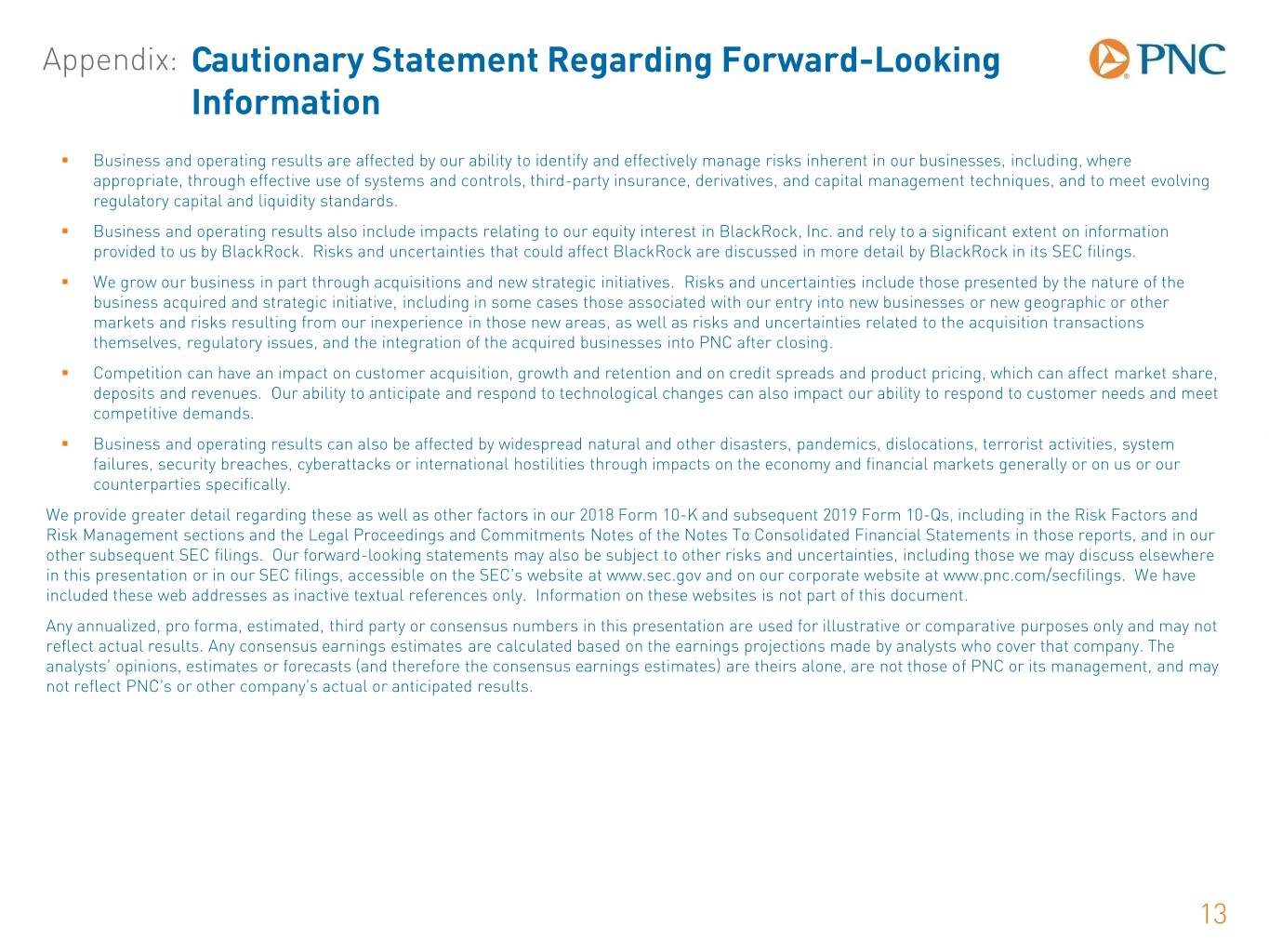
Appendix: Cautionary Statement Regarding Forward-Looking Information . Business and operating results are affected by our ability to identify and effectively manage risks inherent in our businesses, including, where appropriate, through effective use of systems and controls, third-party insurance, derivatives, and capital management techniques, and to meet evolving regulatory capital and liquidity standards. . Business and operating results also include impacts relating to our equity interest in BlackRock, Inc. and rely to a significant extent on information provided to us by BlackRock. Risks and uncertainties that could affect BlackRock are discussed in more detail by BlackRock in its SEC filings. . We grow our business in part through acquisitions and new strategic initiatives. Risks and uncertainties include those presented by the nature of the business acquired and strategic initiative, including in some cases those associated with our entry into new businesses or new geographic or other markets and risks resulting from our inexperience in those new areas, as well as risks and uncertainties related to the acquisition transactions themselves, regulatory issues, and the integration of the acquired businesses into PNC after closing. . Competition can have an impact on customer acquisition, growth and retention and on credit spreads and product pricing, which can affect market share, deposits and revenues. Our ability to anticipate and respond to technological changes can also impact our ability to respond to customer needs and meet competitive demands. . Business and operating results can also be affected by widespread natural and other disasters, pandemics, dislocations, terrorist activities, system failures, security breaches, cyberattacks or international hostilities through impacts on the economy and financial markets generally or on us or our counterparties specifically. We provide greater detail regarding these as well as other factors in our 2018 Form 10-K and subsequent 2019 Form 10-Qs, including in the Risk Factors and Risk Management sections and the Legal Proceedings and Commitments Notes of the Notes To Consolidated Financial Statements in those reports, and in our other subsequent SEC filings. Our forward-looking statements may also be subject to other risks and uncertainties, including those we may discuss elsewhere in this presentation or in our SEC filings, accessible on the SEC’s website at www.sec.gov and on our corporate website at www.pnc.com/secfilings. We have included these web addresses as inactive textual references only. Information on these websites is not part of this document. Any annualized, pro forma, estimated, third party or consensus numbers in this presentation are used for illustrative or comparative purposes only and may not reflect actual results. Any consensus earnings estimates are calculated based on the earnings projections made by analysts who cover that company. The analysts’ opinions, estimates or forecasts (and therefore the consensus earnings estimates) are theirs alone, are not those of PNC or its management, and may not reflect PNC’s or other company’s actual or anticipated results. 13
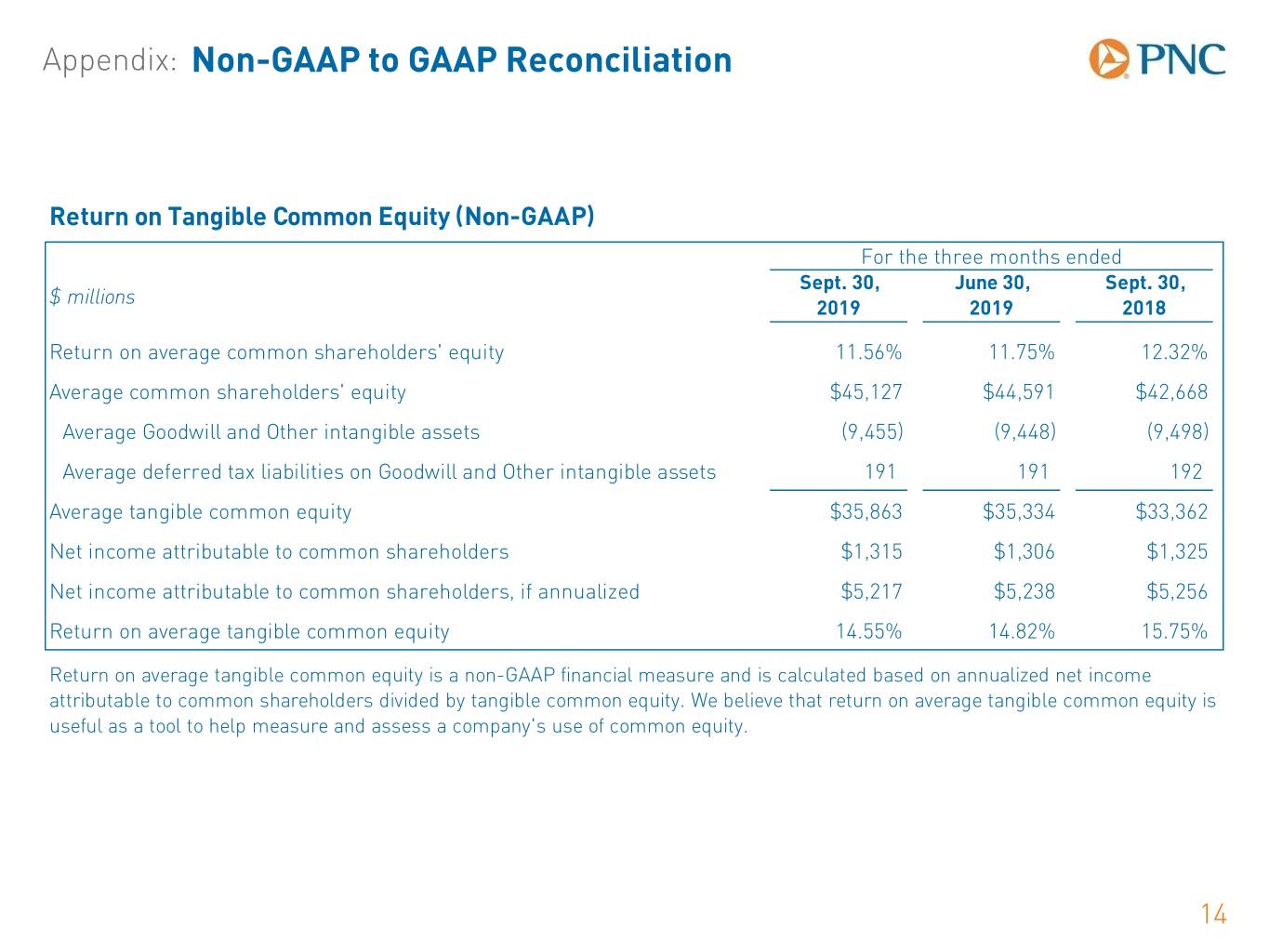
Appendix: Non-GAAP to GAAP Reconciliation Return on Tangible Common Equity (Non-GAAP) For the three months ended Sept. 30, June 30, Sept. 30, $ millions 2019 2019 2018 Return on average common shareholders' equity 11.56% 11.75% 12.32% Average common shareholders' equity $45,127 $44,591 $42,668 Average Goodwill and Other intangible assets (9,455) (9,448) (9,498) Average deferred tax liabilities on Goodwill and Other intangible assets 191 191 192 Average tangible common equity $35,863 $35,334 $33,362 Net income attributable to common shareholders $1,315 $1,306 $1,325 Net income attributable to common shareholders, if annualized $5,217 $5,238 $5,256 Return on average tangible common equity 14.55% 14.82% 15.75% Return on average tangible common equity is a non-GAAP financial measure and is calculated based on annualized net income attributable to common shareholders divided by tangible common equity. We believe that return on average tangible common equity is useful as a tool to help measure and assess a company's use of common equity. 14
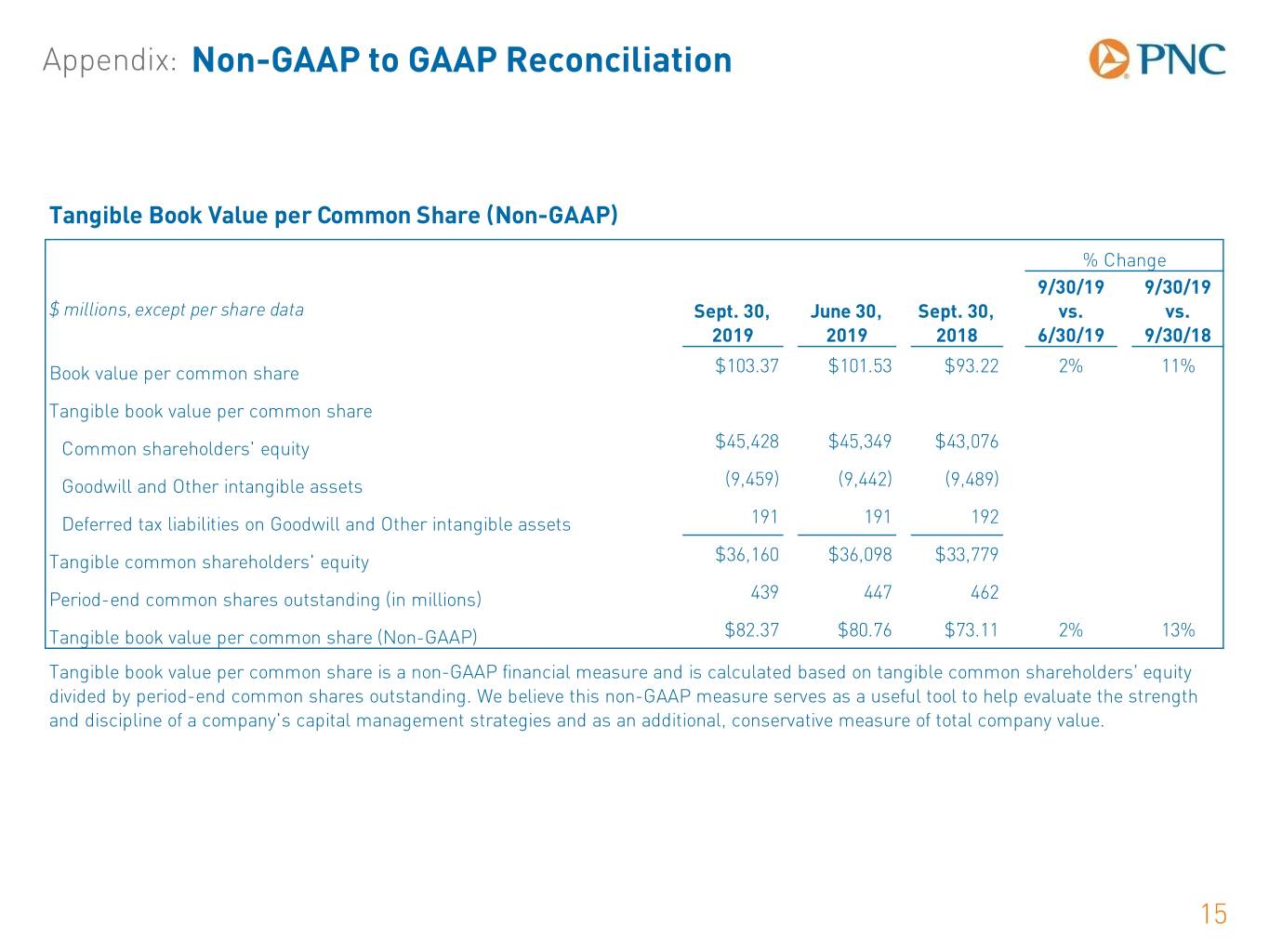
Appendix: Non-GAAP to GAAP Reconciliation Tangible Book Value per Common Share (Non-GAAP) % Change 9/30/19 9/30/19 $ millions, except per share data Sept. 30, June 30, Sept. 30, vs. vs. 2019 2019 2018 6/30/19 9/30/18 Book value per common share $103.37 $101.53 $93.22 2% 11% Tangible book value per common share Common shareholders' equity $45,428 $45,349 $43,076 Goodwill and Other intangible assets (9,459) (9,442) (9,489) Deferred tax liabilities on Goodwill and Other intangible assets 191 191 192 Tangible common shareholders' equity $36,160 $36,098 $33,779 Period-end common shares outstanding (in millions) 439 447 462 Tangible book value per common share (Non-GAAP) $82.37 $80.76 $73.11 2% 13% Tangible book value per common share is a non-GAAP financial measure and is calculated based on tangible common shareholders’ equity divided by period-end common shares outstanding. We believe this non-GAAP measure serves as a useful tool to help evaluate the strength and discipline of a company's capital management strategies and as an additional, conservative measure of total company value. 15

Appendix: Non-GAAP to GAAP Reconciliation Pretax, Pre-Provision Earnings (Non-GAAP) For the three months ended % Change Sept. 30, June 30, Sept. 30, 3Q19 3Q19 $ millions 2019 2019 2018 vs. 2Q19 vs. 3Q18 Net interest income $2,504 $2,498 $2,466 0% 2% Noninterest income 1,989 1,941 1,891 2% 5% Total revenue 4,493 4,439 4,357 1% 3% Noninterest expense 2,623 2,611 2,608 0% 1% Pretax pre-provision earnings $1,870 $1,828 $1,749 2% 7% Net income $1,392 $1,374 $1,400 1% (1%) We believe that pretax, pre-provision earnings, a non-GAAP financial measure, is useful as a tool to help evaluate the ability to provide for credit costs through operations. 16